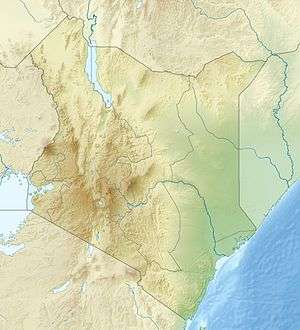Aberdare National Park
| Aberdare National Park | |
|---|---|
|
IUCN category II (national park) | |
|
Aberdare Park entrance | |
 Location of Aberdare National Park | |
| Location | Kenya, Nyandarua County & Nyeri County |
| Nearest city | Nyeri |
| Coordinates | 0°22′48″S 36°41′57″E / 0.38000°S 36.69917°ECoordinates: 0°22′48″S 36°41′57″E / 0.38000°S 36.69917°E |
| Area | 766 km2 (296 sq mi) |
| Established | 1950 |
| Governing body | Kenya Wildlife Service |
The Aberdare National Park covers the higher areas of the Aberdare Mountain Range of central Kenya and the Aberdare Salient to their east. Rhino Ark is a charity devoted to the protection of this critical habitat area.[1]
Overview
The park is located about 100 km north from Nairobi and stretches over a wide variety of terrains because it covers altitudes from about 7,000 feet (2,100 m) to 14,000 feet (4,300 m) above sea level. Established in May 1950, the Aberdare National Park covers an area of 766 square kilometers and forms part of the Aberdare Mountain Range. The park contains a wide range of landscapes - from the mountain peaks that rise to 14,000 feet (4,300 m) above sea level, to their deep, v-shaped valleys intersected by streams, rivers, and waterfalls. Moorland, bamboo forests and rainforests are found at lower altitudes.
Wildlife
Animals easily observed include the leopard, elephant, East African wild dog, giant forest hog, bushbuck, mountain reedbuck, waterbuck, Cape buffalo, suni, side-striped jackal, eland, duiker, olive baboon, black and white colobus monkey, and sykes monkey. Rarer sightings include those of the African golden cat and the bongo - an elusive forest antelope that lives in the bamboo forest. Animals such as the eland as well as spotted and melanistic serval cats can be found higher up in the moorlands. The Aberdare National Park also contains a large eastern black rhinoceros population. Visitors can also indulge in walking, picnics, in the rivers and camping in the moorlands. Even the bird viewing is rewarding, with over 250 species of birds in the park, including the endangered Aberdare cisticola, Jackson's francolin, sparry hawk, goshawks, eagles, sunbirds and plovers. It is a traditional belief of the Kikuyu that the Aberdare Mountain Range, where this park is located, is one of the homes of Ngai, or God. In order to protect the bongo antelope the lions of Aberdare have been moved to other national parks.
Facilities
Visitors to the park can find different types of accommodation according to their taste, ranging from the Treetops tree-house lodge, to the Ark - built in the shape of Noah's Ark - and three self-help banda sites, eight special campsites and a public campsite in the moorland. There are also five picnic sites. Both Treetops and Ark provide excellent nighttime wildlife viewing. From here, visitors can observe various animals, such as elephants, Cape buffaloes and rhinos, which get attracted to the waterholes. The park also includes two airstrips at Mweiga and Nyeri.[2][3]
Park entry and charges
The park is open daily from 6:00 am to 7:00 pm. Entry on foot is prohibited and visitors are turned away after 6:15 pm.
Entry to the park is by smart card only, obtained and loaded at the main gate.
| Rate | Fee |
|---|---|
| East African Citizens (adults) | 300KSh |
| East African students and children | 200 KSh |
| East African Residents (adults) | 1500 KSh |
| East African students and children | 500 KSh |
| Nonresident adults | USD$50 |
| Nonresident students and children | $25 |
References
- ↑ "Environmental Expeditions". www.unep.org. Archived from the original on 17 February 2008. Retrieved 2008-03-17.
- ↑ "Aberdare National Park". Kenya Wildlife Service. 2014-06-29. Retrieved 2017-04-05.
- ↑ "The Ark". thearkkenya.com. Retrieved 2017-04-05.
External links
| Wikivoyage has a travel guide for Aberdare National Park. |
- Kenya Wildlife Service – Aberdare National Park
- World Database on Protected Areas – Aberdare National Park
- United Nations Environmental Programme - Aberdare Range Forests
- Kenyalogy - Aberdares
- Rhino Ark - a charity for the conservation of the Aberdare National Park, "Humans in harmony with habitat and wildlife"
